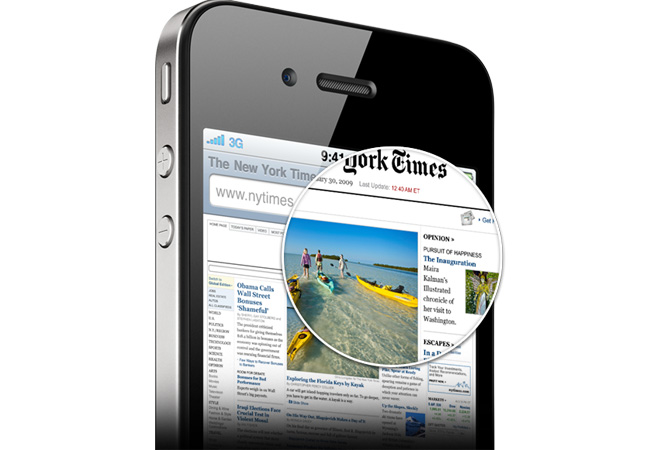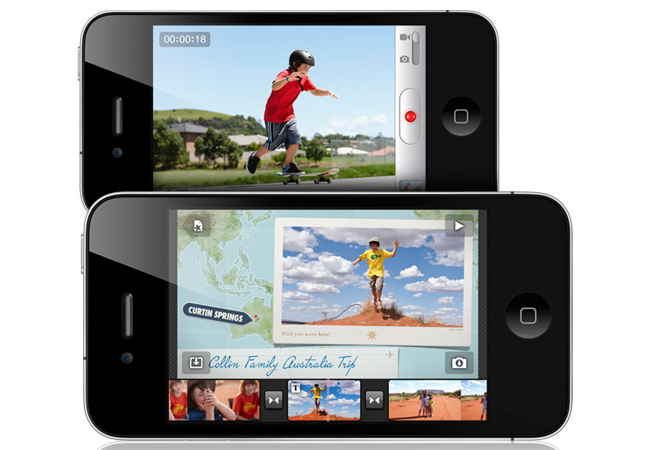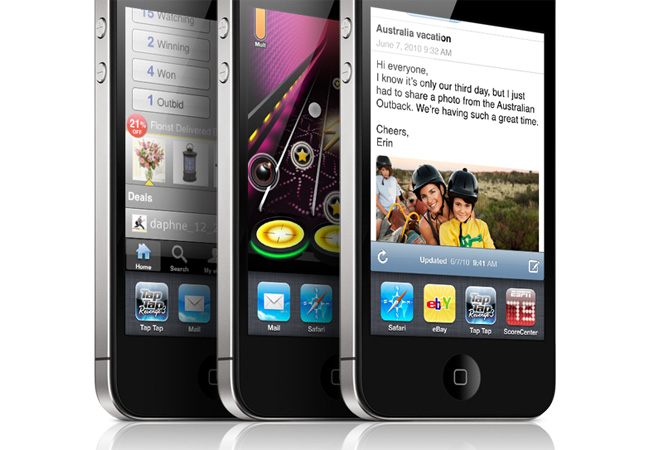Click read more to continue..
Steve Jobs introduced the iPhone 4 today, which he claims offers over 100 new features, though he would focus on only a handful for the keynote. The iPhone 4 looks like the iPhone prototype obtained under questionable circumstances by TeenTelugu: stainless steel casing, all-glass front, and a design Jobs describes as the thinnest smartphone on the planet: almost 25 percent thinner than the iPhone 3GS.. Unlike previous iPhones, the iPhone 4 will have volume controls on the side of the phone along with an accessible microSIM tray. The iPhone 4 features a front-facing camera, and the back sports a microphone, 30pin connector for docking, and a speaker, while the top sports a second microphone for noise cancellation, sleep/wake button, and a headset input.
Jobs went on to highlight the bands around the side of the iPhone 4 that caused much speculation in the wake of the leaked prototypes. Jobs identified them as part of the phone’s antenna system, saying the stainless steel band is also a primarily structural element of the device. The antenna supports all the iPhone 4’s wireless capability, from 3G to Wi-Fi to Bluetooth to GPS along with cellular communications.
 iPhone 4: Retina Display
iPhone 4: Retina Display
The iPhone 4 will also sport what Jobs described as a “retina display” with four times the pixel density of a typical LCD display at a whopping 326 pixels per inch—by far denser than anything else in the consumer electronics market. The result is a 3.5-inch display with a native resolution of 960 by 640 pixels that is actually a higher resolution than the typical human eye is capable of perceiving, when held at a distance of just 10 to 12 inches. Jobs claims the iPhone 4’s display winds up looking like a high quality printed book (albeit that emits light!) rather than a blocky pixellated grid. The iPhone OS automatically handles rendering text and controls at the higher resolution for the iPhone 4, so developers don’t need to do anything to update their applications to look good on the new display…but, of course, if developers want to add higher-resolution graphics to their apps, they will look stunning on the iPhone 4.
iPhone 4: A4 Chip and Gyroscope
The iPhone 4 will also feature an Apple-designed A4 CPU, following along the lines of the processor powering the iPad. Jobs said the A4 processor improved power management, so the iPhone 4 will manage 40 percent more talk time on 3G networks (up to 7 hours), or up to 6 hours of 3G Web browsing or 10 hours of Wi-Fi browsing. The device can also play up to 10 hours of video, 40 hours of music, and should have an standby time of up to 300 hours. The iPhone 4 will also pack up to 32 GB of onboard flash storage, and will offer quad-band HSDPA/HSUPA for mobile broadband speeds up to 7.2Mbps downstream, 4.8Mbps upstream…assuming carrier networks support that technology. The iPhone 4 will also support 802.11n Wi-Fi, assisted GPS, Bluetooth, and packs and accelerometer, compass, proximity sensor, and an ambient light sensor,. The iPhone 4 also sports a gyroscope, which enables six-axis motion sensing…just like a game controller, and iPhone OS 4 will offer developer APIs to leverage the gyroscope: Jobs envisions the gyroscope enabling whole new types of mobile gaming.
 iPhone 4: Camera & iMovie
iPhone 4: Camera & iMovie
The iPhone 4 will feature a 5 megapixel camera with a backside-illuminated sensor, which Jobs says increases the amount of light captured by the sensor, resulting in better photographs, particularly in low-light situations. The camera will also record HD video at 720p resolution and 30 frames per second, and the LED flash can be used to light video as well. Like the iPhone 3GS, the iPhone 4 will feature in-phone video editing and enable users to share video the the Internet (think Facebook and YouTube). However, Apple is pushing the video editing envelope with a new iMovie application for iPhone, that enables users to assemble and trim clips and record directly into an iMovie timeline. Users can also add camera photos to their movies (complete with the pan-and-scan Ken Burns effect), and iMovie for iPhone will enable users to add titles and transitions to their videos. The iPhone 4 camera embeds geolocation information in video; iMovie for iPhone can optional display display that information. Users can also add music as a soundtrack to their video, and select from a number of pre-generated themes. iMovie for iPhone will be available as a separate purchase from the App Store for $4.99.
iPhone 4: Bing
Among new features in iOS 4 will be an option to use Microsoft’s Bing as a default search engine; Google will still be the iPhone’s default search, but Yahoo and Bing-powered searches will be available as options. Note that Bing will be taking over the back end for Yahoo’s search services later this year.
iBooks for iPhone
Apple also announced a version of iBooks will be available for iPhone, with feature parity to the iPad edition (complete with previously-announced PDF and annotations support). The applications will be able to synchronize across devices, so users will be able to start reading an iBook on an iPad, then pick up at the same spot on the iPhone. Users will be able to download purchased books to all their supported devices at no extra charge.
 No Longer iPhone OS 4: iOS 4
No Longer iPhone OS 4: iOS 4
Since it won’t do to have an iPad running something called “iPhone OS,” Apple has decided to rename its mobile device operating system to simply “iOS 4,” encompassing all its mobile devices: the iPhone, the iPad, and the iPod touch. iOS 4 will have the features Apple outlined back in April, including a form of multitasking support (so applications like Pandora can stream music in the background while an iPhone user, say, surfs the Web in Safari), a unified Mail inbox that supports multiple services, home screen folders, a Game Center, and improved support for Microsoft Exchange and enterprise users. However, developers will probably be more intrigued by a boatload of new APIs and significantly deepened features. Developers at WWDC will be able to set hands on a release candidate today.
iAds
Jobs also took a moment to highlight Apple’s new in-application advertising platform iAds: according to Jobs, Apple is developing iAds as a revenue channel for developers so they can earn money from applications in ways other than direct sales to users. As outlined last April, Apple is aiming for high amounts of interactivity and engagement with iAds, building on HTML5 technologies rather than the still-industry-standard Adobe Flash. Apple will host all the advertising and handle ad sales, so all applications developers have to do is specify where in the applications the ads should be placed, then collect 60 percent of the revenue from placements in their applications. Apple has only been selling iAds for about two months they should go live Jule 1 and so far has many major brands on board, including Disney (Jobs is Disney’s biggest single shareholder, remember), Target, Best Buy, Geico, DirecTV, and other major brands. Unlike traditional banner ads that eject users from applications out into Web browsers, iAds run without exiting a user’s application, providing an interactive experience without causing people to leave apps, or lose work or messages: the goal is an engaging experience that users know is “safe” regardless of the app they’re using.
 Video Calling
Video Calling
Of course, that front-facing camera in the iPhone 4 exists for one and only one purpose: video calls. Jobs demonstrated what Apple is dubbing FaceTime video calling with the iPhone 4. The feature will initially be Wi-Fi only and operate iPhone 4 devices no word in whether FaceTime will support, say, desktops or notebooks equipped with cameras. Users will be able to switch to the rear-mounted 5 megapixel camera on the iPhone 4 to let callers see what they’re seeing, or stick with the front-facing camera for face-to-face chat. Jobs says Apple plans to work with mobile operators to make FaceTime available over 3G data services. Apple says it plans to ship millions of FaceTime-capable devices this year and if current iPhone sales are any indicator, they’re right so iPhone 4 users will have plenty of people to talk to. (How far off is an app called FaceTime Roulette?)
Apple says the technology behind FaceTime will be come an industry standard, and will be supported by other devices and services...Watch apple official video on iphone 4


0 comments:
Post a Comment